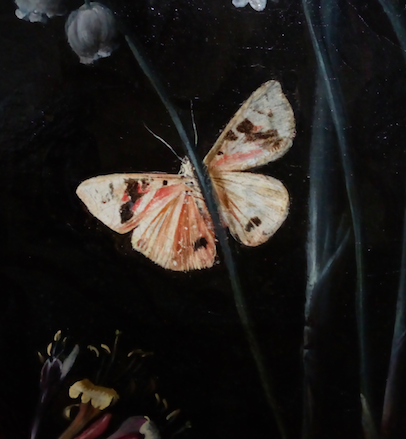V.E. Mandrij
“One could ornament a painting with the wings of a butterfly”: A technical study of “Schmetterlingsabdruck” developed by Otto Marseus van Schrieck (1620/21-1678) in his sottobosco paintings

© V. Mandry
In the mid-1650’s, the Dutch painter Otto Marseus van Schrieck (1620/21-78) travelled to Italy and developed the sottobosco paintings. These images represent small-scaled animals such as reptiles, batrachians and insects in natural-like surroundings. Instead of depicting butterflies through paint, Marseus sometimes used a method of transferring real butterfly scales on the canvas. When secondary literature about the sottoboschi uses the term “Schmetterlingsabdruck”, the same technique is called “lepidochromy” in natural philosophical fields. This method of specimen conservation was a common practice from the 18th century onwards by entomologists. However, Marseus seems to be one of the precursors. This technique synthesizes his interests in art and natural history as well as displays his ambition to challenge nature by increasing the mimetic aspect of his paintings and blurring borders between art and nature.
This PhD project investigates the stylistic, material and technical elements of the “Schmetterlingsabdruck” as well as its visual effects on beholders in the context of early modern art collections. It will be question of analyzing a corpus of sottoboschi by Marseus and his followers and use conservation methods such as historical reconstruction of 18th-century lepidochromy recipes. The purpose of this research is to provide a better understanding of this particular technique in its art historical context.
Personal Data
V.E. Mandrij obtained a B.A. degree in Art History and French Literature at the University of Geneva. In 2018, s/he received a Research M.A. degree (Cum Laude) in Art History of the Low Countries at Utrecht University and was awarded a fellowship grant at the Royal Netherlands Institute in Rome. Furthermore, s/he interned at the museum Mayer van den Bergh in Antwerp for researching its collection of still lives for several months.
Mandrij is particularly interested in:
- poetics - natural history – nature theory - art;
- beholders’ interactions with artworks;
- material collecting culture and (paintings representing) curiosity cabinets;
- 17th-century European still-life paintings;
- early modern depictions of insects;
- artistic techniques, materiality and uses of organic materials in paintings.
Mandrij’s Master thesis addressed the potential relationship between Otto Marseus van Schrieck’s success in Rome during the 17th-century and the contemporary rising interest in the antique concept of the sublime. Hir current PhD project at the University of Konstanz analyses further this subject and concerns art historical research of the technique of “Schmetterlingsabdruck” in sottobosco paintings using interdisciplinary methodologies.
Besides, s/he writes prose fictions and several texts in French have been published in Swiss anthologies.
Supervisory Team | |
|---|---|
| Primary Supervisor | Prof. Dr. Karin Leonhard, Uni Konstanz |
| Secondary Supervisor | Prof. Dr. Thijs Weststeijn, Universität Utrecht |
| Mentors | Prof. Dr. Gregor J. M. Weber, Rijksmuseum Amsterdam |
| Dr. Doris Oltrogge, Institut für Restaurierungs- und Konservierungswissenschaft, TH Köln | |
| Project Partners | Rijksmuseum, Amsterdam |
